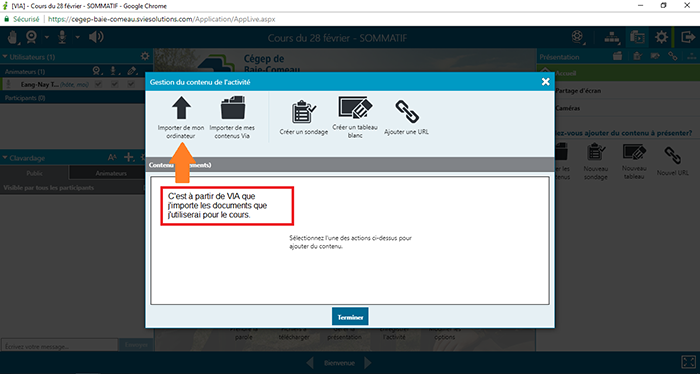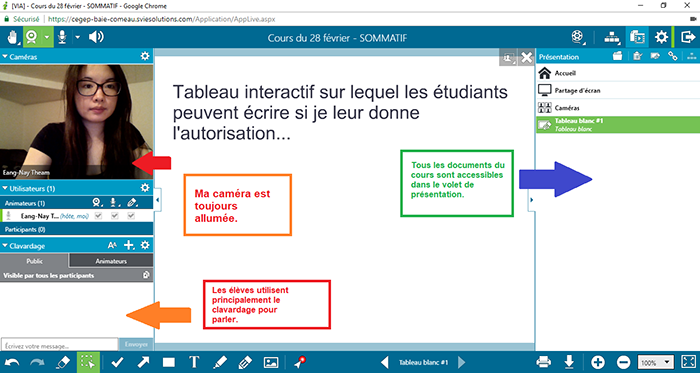My first experience with distance education as a new teacher
In the fall of 2017, during my first year of teaching in a college, I was offered the possibility of giving the second literature course, Littérature et imaginaire (Literature and Imagination), as an evening distance-education class. That class comes after Écriture et littérature (Writing and Literature) (101) and precedes the Littérature québecoise (Literature from Quebec) (103) class. I was giving regular, in-class courses at the same time. I would like to tell you about my experience and share with you some strategies that encourage the students’ engagement. I would like to start by saying that I loved my experience!
A course offering focused on the needs of the students
For the fall 2017 course, I had never given the course before and I built all the documents to adapt them to the distance education format. The students join me on VIA. Some use a camera, but bandwidth usage needs to be taken into consideration. I think that the format that we used (synchronous) maximizes their chances of success by offering the students a maximum of support. The class is recorded and I can make it available online after its original broadcast, but we try to have the distance-education students present synchronously. We want them to take the class seriously and to participate in the class. Nevertheless, I remain available for the students if they have questions. Our communications are done through emails, MIOs (Omnivox Instant Messages), and, sometimes, through Skype calls.
I also give a course in continuing education. The students’ profile is different: they are mainly adult with other obligations. They have the possibility of participating in the class or taking it asynchronously, because it is recorded. All have the chance to re-view the class.
Support offered to the students
During a meeting, before even the beginning of the course, the ICT counsellor of our college at that time, Stéphanie Coll, explained the various modes of working to the students. They have access to a guide that explains how we work with the VIA platform. During the first class, I review those elements briefly. The students also have access to Moodle where all the documents can be found, as well as their assignments.

Overview of how VIA works – importing files

Overview of how VIA works – chatroom, camera and presentation tab
My strategies to engage my distance-education students
- I center all of my interventions on the VIA platform. If the students go elsewhere, it provokes inattentiveness and misunderstandings.
- I use screen sharing to demonstrate ideas and elements of content.
- To get them engaged, I create 3- to 4-student discussion groups and I move among them.
- Afterward, the students can re-listen to the exchanges or consult the chat history.
- I pay a special attention to the structure of the classes; that is to say that the activities offered must take into consideration the distance-education format (the activities cannot have the same pedagogy as your in-class activities). My presentations will be more detailed, because I do not want to move from one tool to another, as opposed to a physical classroom where I can support my lectures with the whiteboard.
I also use texts that I have annotated, either by hand and then scanned, or directly through Word. I also create audio commentaries using the Screencast-O-Matic app. It is interesting to present video excerpts to demonstrate how literature can be made current and relevant. But, there is a problem: on VIA, all videos need to be on YouTube. As not all videos are easily found on there, I am currently looking for a solution.
A format appreciated by the students
I surveyed my fall 2017 group and the feedback is excellent! I also think that teaching style plays a large role.
Despite the distance, my students told me that I was lively, expressive and motivated. That is always enjoyable to read!
Introverted students greatly appreciate the format: they ask questions in private, use the chat, show their appreciation with a thumbs-up. With last fall’s experience and this survey, I added more possibilities to interact in the virtual classroom:
- By integrating more activities, such as having them write on the interactive whiteboard
- By asking them for feedback more often with a thumbs-up (or its opposite) to make sure that they understand what I am explaining
- By asking questions to the least active students
In the winter 2018 semester, I am giving the third literature class (Literature from Quebec), still in the evening-class format. Out of my thirty-something students, 6 are from Baie-Comeau. The others come from all around Quebec (Thetford, Matane, Rivière-du-Loup, Ste-Anne-des-Monts). Out of the 32 students registered for the winter 2018 class, a quarter had already taken my class in the fall. I will be able to tell you more after this semester, but it is off to a good start!
And you, have you experienced a method of distance education? Thank you for sharing your experience.

